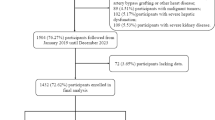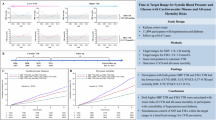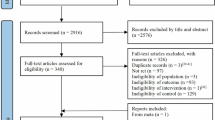Abstract
The second derivative of the finger photoplethysmogram (SDPTG) has been used as a non-invasive examination for arterial stiffness. The present study sought to elucidate independent determinants of the SDPTG among various cardiovascular risk factors in middle-aged Japanese men. The SDPTG was obtained from the cuticle of the left-hand forefinger in 973 male workers (mean age: 44±6 years) during a medical checkup at a company. The SDPTG indices (b/a and d/a) were calculated from the height of the wave components. Multiple logistic regression analyses revealed that the independent determinants of an increased b/a (highest quartile of the b/a) were age (odds ratio [OR]: 1.12 per 1-year increase, 95% confidence interval [CI]: 1.09–1.15), hypertension (OR: 1.65, 95% CI: 1.03–2.65), dyslipidemia (OR: 1.51, 95% CI: 1.09–2.09), impaired fasting glucose/diabetes mellitus (OR: 2.43, 95% CI: 1.16–5.07), and a lack of regular exercise (OR: 2.00, 95% CI: 1.29–3.08). Similarly, independent determinants of a decreased d/a (lowest quartile of the d/a) were age (OR: 1.11 per 1-year increase, 95% CI: 1.08–1.14), hypertension (OR: 3.44, 95% CI: 2.20–5.38), and alcohol intake 6 or 7 days per week (OR: 2.70, 95% CI: 1.80–4.06). No independent association was observed between the SDPTG indices and blood leukocyte count or serum C-reactive protein levels. In conclusion, the SDPTG indices reflect arterial properties affected by several cardiovascular risk factors in middle-aged Japanese men. The association between inflammation and the SDPTG should be evaluated in further studies.
Similar content being viewed by others
Article PDF
References
Willum-Hansen T, Staessen JA, Torp-Pedersen C, et al: Prognostic value of aortic pulse wave velocity as index of arterial stiffness in the general population. Circulation 2006; 113: 664–670.
Oliver JJ, Webb DJ : Noninvasive assessment of arterial stiffness and risk of atherosclerotic events. Arterioscler Thromb Vasc Biol 2003; 23: 554–566.
Shokawa T, Imazu M, Yamamoto H, et al: Pulse wave velocity predicts cardiovascular mortality: findings from the Hawaii–Los Angeles–Hiroshima study. Circ J 2005; 69: 259–264.
Dolan E, Thijs L, Li Y, et al: Ambulatory arterial stiffness index as a predictor of cardiovascular mortality in the Dublin Outcome Study. Hypertension 2006; 47: 365–370.
Takazawa K, Tanaka N, Fujita M, et al: Assessment of vasoactive agents and vascular aging by the second derivative of photoplethysmogram waveform. Hypertension 1998; 32: 365–370.
Imanaga I, Hara H, Koyanagi S, Tanaka K : Correlation between wave components of the second derivative of plethysmogram and arterial distensibility. Jpn Heart J 1998; 39: 775–784.
Hashimoto J, Watabe D, Kimura A, et al: Determinants of the second derivative of the finger photoplethysmogram and brachial-ankle pulse-wave velocity: the Ohasama study. Am J Hypertens 2005; 18: 477–485.
Otsuka T, Kawada T, Katsumata M, Ibuki C : Utility of second derivative of the finger photoplethysmogram for the estimation of the risk of coronary heart disease in the general population. Circ J 2006; 70: 304–310.
Ohshita K, Yamane K, Ishida K, Watanabe H, Okubo M, Kohno N : Post-challenge hyperglycaemia is an independent risk factor for arterial stiffness in Japanese men. Diabet Med 2004; 21: 636–639.
Hashimoto J, Chonan K, Aoki Y, et al: Pulse wave velocity and the second derivative of the finger photoplethysmogram in treated hypertensive patients: their relationship and associating factors. J Hypertens 2002; 20: 2415–2422.
Bortolotto LA, Blacher J, Kondo T, Takazawa K, Safar ME : Assessment of vascular aging and atherosclerosis in hypertensive subjects: second derivative of photoplethysmogram versus pulse wave velocity. Am J Hypertens 2000; 13: 165–171.
Roberts WL : CDC/AHA Workshop on Markers of Inflammation and Cardiovascular Disease: Application to Clinical and Public Health Practice: laboratory tests available to assess inflammation-performance and standardization: a background paper. Circulation 2004; 110: e572–e576.
Teramoto T, Sasaki J, Ueshima H, et al: Executive summary of Japan Atherosclerosis Society (JAS) guideline for diagnosis and prevention of atherosclerotic cardiovascular diseases for Japanese. J Atheroscler Thromb 2007; 14: 45–50.
Jespersen LT, Pedersen OL : The quantitative aspect of photoplethysmography revised. Heart Vessels 1986; 2: 186–190.
Iketani Y, Iketani T, Takazawa K, Murata M : Second derivative of photoplethysmogram in children and young people. Jpn Circ J 2000; 64: 110–116.
Pannier BM, Avolio AP, Hoeks A, Mancia G, Takazawa K : Methods and devices for measuring arterial compliance in humans. Am J Hypertens 2002; 15: 743–753.
Stewart AD, Millasseau SC, Kearney MT, Ritter JM, Chowienczyk PJ : Effects of inhibition of basal nitric oxide synthesis on carotid-femoral pulse wave velocity and augmentation index in humans. Hypertension 2003; 42: 915–918.
Kelly RP, Millasseau SC, Ritter JM, Chowienczyk PJ : Vasoactive drugs influence aortic augmentation index independently of pulse-wave velocity in healthy men. Hypertension 2001; 37: 1429–1433.
Lehmann ED, Watts GF, Fatemi-Langroudi B, Gosling RG : Aortic compliance in young patients with heterozygous familial hypercholesterolaemia. Clin Sci (Lond) 1992; 83: 717–721.
Cameron JD, Jennings GL, Dart AM : The relationship between arterial compliance, age, blood pressure and serum lipid levels. J Hypertens 1995; 13: 1718–1723.
Giannattasio C, Mangoni AA, Failla M, et al: Impaired radial artery compliance in normotensive subjects with familial hypercholesterolemia. Atherosclerosis 1996; 124: 249–260.
Wilkinson IB, Prasad K, Hall IR, et al: Increased central pulse pressure and augmentation index in subjects with hypercholesterolemia. J Am Coll Cardiol 2002; 39: 1005–1011.
Farrar DJ, Bond MG, Riley WA, Sawyer JK : Anatomic correlates of aortic pulse wave velocity and carotid artery elasticity during atherosclerosis progression and regression in monkeys. Circulation 1991; 83: 1754–1763.
Pynadath TI, Mukherjee DP : Dynamic mechanical properties of atherosclerotic aorta. A correlation between the cholesterol ester content and the viscoelastic properties of atherosclerotic aorta. Atherosclerosis 1977; 26: 311–318.
Partridge CR, Sampson HW, Forough R : Long-term alcohol consumption increases matrix metalloproteinase-2 activity in rat aorta. Life Sci 1999; 65: 1395–1402.
Zieman SJ, Melenovsky V, Kass DA : Mechanisms, pathophysiology, and therapy of arterial stiffness. Arterioscler Thromb Vasc Biol 2005; 25: 932–943.
Niederhoffer N, Kieffer P, Desplanches D, Lartaud-Idjouadiene I, Sornay MH, Atkinson J : Physical exercise, aortic blood pressure, and aortic wall elasticity and composition in rats. Hypertension 2000; 35: 919–924.
Nosaka T, Tanaka H, Watanabe I, Sato M, Matsuda M : Influence of regular exercise on age-related changes in arterial elasticity: mechanistic insights from wall compositions in rat aorta. Can J Appl Physiol 2003; 28: 204–212.
Hayashi K, Sugawara J, Komine H, Maeda S, Yokoi T : Effects of aerobic exercise training on the stiffness of central and peripheral arteries in middle-aged sedentary men. Jpn J Physiol 2005; 55: 235–239.
Sugawara J, Otsuki T, Tanabe T, Hayashi K, Maeda S, Matsuda M : Physical activity duration, intensity, and arterial stiffening in postmenopausal women. Am J Hypertens 2006; 19: 1032–1036.
DeSouza CA, Shapiro LF, Clevenger CM, et al: Regular aerobic exercise prevents and restores age-related declines in endothelium-dependent vasodilation in healthy men. Circulation 2000; 102: 1351–1357.
Okamura T, Moriyama Y, Kadowaki T, Kanda H, Ueshima H : Non-invasive measurement of brachial-ankle pulse wave velocity is associated with serum C-reactive protein but not with α-tocopherol in Japanese middle-aged male workers. Hypertens Res 2004; 27: 173–180.
Saijo Y, Utsugi M, Yoshioka E, et al: Relationship of β2-microglobulin to arterial stiffness in Japanese subjects. Hypertens Res 2005; 28: 505–511.
Vlachopoulos C, Dima I, Aznaouridis K, et al: Acute systemic inflammation increases arterial stiffness and decreases wave reflections in healthy individuals. Circulation 2005; 112: 2193–2200.
Yasmin, McEniery CM, Wallace S, Mackenzie IS, Cockcroft JR, Wilkinson IB : C-reactive protein is associated with arterial stiffness in apparently healthy individuals. Arterioscler Thromb Vasc Biol 2004; 24: 969–974.
Andoh N, Minami J, Ishimitsu T, Ohrui M, Matsuoka H : Relationship between markers of inflammation and brachial-ankle pulse wave velocity in Japanese men. Int Heart J 2006; 47: 409–420.
Greenland P, Daviglus ML, Dyer AR, et al: Resting heart rate is a risk factor for cardiovascular and noncardiovascular mortality: the Chicago Heart Association Detection Project in Industry. Am J Epidemiol 1999; 149: 853–862.
Okamura T, Hayakawa T, Kadowaki T, et al: Resting heart rate and cause-specific death in a 16.5-year cohort study of the Japanese general population. Am Heart J 2004; 147: 1024–1032.
Laurent S, Cockcroft J, Van Bortel L, et al: Expert consensus document on arterial stiffness: methodological issues and clinical applications. Eur Heart J 2006; 27: 2588–2605.
Author information
Authors and Affiliations
Corresponding author
Rights and permissions
About this article
Cite this article
Otsuka, T., Kawada, T., Katsumata, M. et al. Independent Determinants of Second Derivative of the Finger Photoplethysmogram among Various Cardiovascular Risk Factors in Middle-Aged Men. Hypertens Res 30, 1211–1218 (2007). https://doi.org/10.1291/hypres.30.1211
Received:
Accepted:
Issue date:
DOI: https://doi.org/10.1291/hypres.30.1211
Keywords
This article is cited by
-
Second derivative of the finger photoplethysmogram and cardiovascular mortality in middle-aged and elderly Japanese women
Hypertension Research (2017)
-
Usefulness of the second derivative of the finger photoplethysmogram for assessment of end-organ damage: the J-SHIPP study
Hypertension Research (2016)



